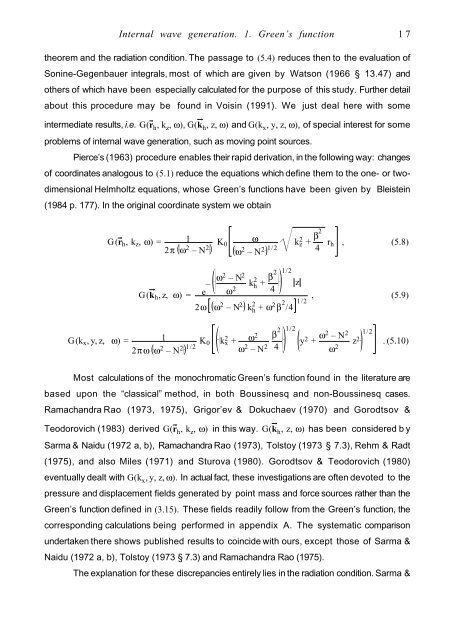Internal Wave Generation in Uniformly Stratified Fluids. 1 ... - LEGI
Internal Wave Generation in Uniformly Stratified Fluids. 1 ... - LEGI
Internal Wave Generation in Uniformly Stratified Fluids. 1 ... - LEGI
You also want an ePaper? Increase the reach of your titles
YUMPU automatically turns print PDFs into web optimized ePapers that Google loves.
theorem and the radiation condition. The passage to (5.4) reduces then to the evaluation of<br />
Son<strong>in</strong>e-Gegenbauer <strong>in</strong>tegrals, most of which are given by Watson (1966 § 13.47) and<br />
others of which have been especially calculated for the purpose of this study. Further detail<br />
about this procedure may be found <strong>in</strong> Vois<strong>in</strong> (1991). We just deal here with some<br />
<strong>in</strong>termediate results, i.e. G(r h , k z , ω), G(k h , z, ω) and G(k x , y, z, ω), of special <strong>in</strong>terest for some<br />
problems of <strong>in</strong>ternal wave generation, such as mov<strong>in</strong>g po<strong>in</strong>t sources.<br />
Pierce’s (1963) procedure enables their rapid derivation, <strong>in</strong> the follow<strong>in</strong>g way: changes<br />
of coord<strong>in</strong>ates analogous to (5.1) reduce the equations which def<strong>in</strong>e them to the one- or two-<br />
dimensional Helmholtz equations, whose Green’s functions have been given by Bleiste<strong>in</strong><br />
(1984 p. 177). In the orig<strong>in</strong>al coord<strong>in</strong>ate system we obta<strong>in</strong><br />
G(kx, y, z, ω) =<br />
<strong>Internal</strong> wave generation. 1. Green’s function 17<br />
G(rh, kz, ω) =<br />
1<br />
2π ω2 K0<br />
ω<br />
– N2 G(kh, z, ω) = e – ω2 – N2 ω2 ω 2 – N 2 1/2<br />
k h 2 + β 2<br />
4<br />
1/2<br />
2ω ω 2 – N 2 k h 2 + ω 2 β 2 /4 1/2<br />
1<br />
2πω ω2 – N2 1/2 K0 kx 2 + ω2<br />
ω2 β2<br />
– N2 4<br />
1/2<br />
kz 2 + β2<br />
4 rh , (5.8)<br />
z<br />
, (5.9)<br />
y 2 + ω2 – N 2<br />
ω 2<br />
z2 1/2<br />
. (5.10)<br />
Most calculations of the monochromatic Green’s function found <strong>in</strong> the literature are<br />
based upon the “classical” method, <strong>in</strong> both Bouss<strong>in</strong>esq and non-Bouss<strong>in</strong>esq cases.<br />
Ramachandra Rao (1973, 1975), Grigor’ev & Dokuchaev (1970) and Gorodtsov &<br />
Teodorovich (1983) derived G(r h , k z , ω) <strong>in</strong> this way. G(k h , z, ω) has been considered by<br />
Sarma & Naidu (1972 a, b), Ramachandra Rao (1973), Tolstoy (1973 § 7.3), Rehm & Radt<br />
(1975), and also Miles (1971) and Sturova (1980). Gorodtsov & Teodorovich (1980)<br />
eventually dealt with G(k x , y, z, ω). In actual fact, these <strong>in</strong>vestigations are often devoted to the<br />
pressure and displacement fields generated by po<strong>in</strong>t mass and force sources rather than the<br />
Green’s function def<strong>in</strong>ed <strong>in</strong> (3.15). These fields readily follow from the Green’s function, the<br />
correspond<strong>in</strong>g calculations be<strong>in</strong>g performed <strong>in</strong> appendix A. The systematic comparison<br />
undertaken there shows published results to co<strong>in</strong>cide with ours, except those of Sarma &<br />
Naidu (1972 a, b), Tolstoy (1973 § 7.3) and Ramachandra Rao (1975).<br />
The explanation for these discrepancies entirely lies <strong>in</strong> the radiation condition. Sarma &


